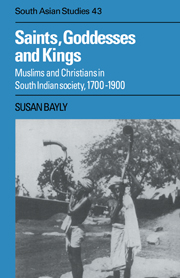Book contents
- Frontmatter
- Contents
- List of plates
- List of maps
- Preface
- Note on transliteration
- List of abbreviations
- Introduction
- Part I
- 1 South Indian religion and society
- 2 The development of Muslim society in Tamilnad
- 3 The Muslim religious tradition in south India
- 4 The south Indian state and the creation of Muslim community
- 5 Warrior martyr pirs in the eighteenth century
- 6 The final period of nawabi rule in the Carnatic
- Part II
- Select glossary
- Bibliography
- Index
- CAMBRIDGE SOUTH ASIAN STUDIES
- Plate section
5 - Warrior martyr pirs in the eighteenth century
from Part I
Published online by Cambridge University Press: 04 December 2009
- Frontmatter
- Contents
- List of plates
- List of maps
- Preface
- Note on transliteration
- List of abbreviations
- Introduction
- Part I
- 1 South Indian religion and society
- 2 The development of Muslim society in Tamilnad
- 3 The Muslim religious tradition in south India
- 4 The south Indian state and the creation of Muslim community
- 5 Warrior martyr pirs in the eighteenth century
- 6 The final period of nawabi rule in the Carnatic
- Part II
- Select glossary
- Bibliography
- Index
- CAMBRIDGE SOUTH ASIAN STUDIES
- Plate section
Summary
As can be seen from the case of the Eruvadi saint, Saiyid Ibrahim Sultan, warlike hero Sufis have been familiar figures in south India for many centuries. Indeed in a sense every Sufi is a warrior. Everywhere in the Muslim world Sufi literature abounds in images of war and conquest. In devotional works the term jihad (holy war) has long been a favourite metaphor for the Sufi's inner struggle, and armed avenger pirs have come to be known and venerated in Muslim societies as far apart as the Caucasus and the Anatolian plain, Bengal and central Java. In south India too the portrayal of Sufis as demon-slayers and supernatural warriors is something which certainly predated the founding of the two nawabi regimes. But for all the familiarity of these martial themes and images, it was in the eighteenth-century that the tradition of the warrior pir came to acquire a new and much more specific significance in south Indian society. In the Tamil country in particular, cult veneration came increasingly to be focused on the figure of the hero martyr or ghazi-shahid. Rather than being described as a conventional tariqa Sufi or even as an unaffiliated holy man, these pirs appear in the texts and oral traditions as straightforward military men. They are often identified with Sikandar or with the other semi-historical Muslim heroes, but they are thought of primarily as martyred hero–kings and conquerors. Such a Sufi's death and transition to cult saint status takes place in a sharply visualised political and strategic landscape, the landscape of eighteenth-century warfare and state-building.
- Type
- Chapter
- Information
- Saints, Goddesses and KingsMuslims and Christians in South Indian Society, 1700–1900, pp. 187 - 215Publisher: Cambridge University PressPrint publication year: 1990



